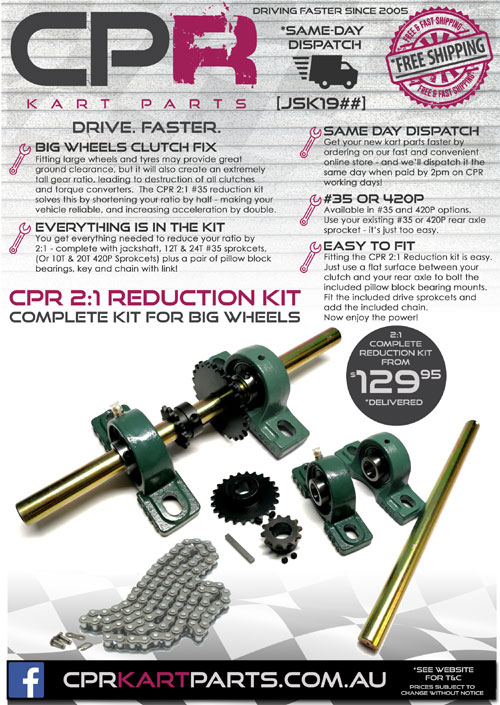GUIDE Calculating Top Speeds and Clutch Engagement Road Speed
GUIDE Calculating Top Speeds and Clutch Engagement Road Speed
POTENTIAL TOP SPEED CALCULATOR (AND CLUTCH ENGAGEMENT ROAD SPEED)
Not sure what the top speed of your project might be? You can use this calculator to determine what the theoretical top speed of your project will be based on the size of your rear wheels (including tyre) and the maximum RPM of your engine, as well as the gear ratios you are using.
You can also use this calculator to determine what the minimum speed you can travel at will be while the clutch is completely engaged. This can help determine the best ratio if you are intending on travelling slowly (for example, using off-road wheels in a paddock with kids driving). Scroll down to learn how to use the calculator for this purpose.
HOW TO USE THE CALCULATOR
*NOTE: If you wish to use the calculator to check the minimum speed required for full clutch engagement, please scroll to the bottom of this guide.
The calculator is simple - it's not important which pitch transmission chain you're using, the important parts are:
1. Enter Maximum Safe Engine RPM
ENGINE MAXIMUM RPM
If you are running a governed 4-stroke, maximum RPM will be around 3600rpm. In this case, enter 3600 into the safe maximum RPM field in the calculator
If you're running an ungoverned 4-stroke then it may be around 6000rpm unmodified, or over 7000rpm if modified. Generally the Torini Clubmaxx will reach 6200rpm with the stock coil.
If you are running a 2-stroke enigne, this will vary considerably but most are around 15,000rpm.
2. Enter Tire Size Diameter
REAR WHEEL SIZE
You'll need to calculate the over-all diameter of the wheel and tyre package you're using. Measure the wheel from the ground, to the top of the tyre in inches if possible. If you are measuring in metric, use milimeters. Convert to inches by dividing by 25.4 - for example if youre wheels are 406mm then they will be 406mm divided by 25.4 = ~16 inches. In this case, enter "16" into the calculator for this field.
3. Enter Differential Gear Ratio (NOTE: THIS VALUE IS ONLY NEEDED IF YOU ARE RUNNING A JACKSHAFT OR TORQUE CONVERTER - JUST LEAVE IT AS DEFAULT OTHERWISE)
REDUCTION JACKSHAFT RATIO
If you are running a simple dry clutch and rear axle sprocket (no jackshaft or torque converter) then enter the default value "1" into this field.
If you are running an additional reduction (say a torque converter) then you need to add that reduciton as well. For example, if you have a 12T on the torque converter jackshaft and a 60T on the axle shaft, then you have 5:1 (see above). The torque converter will likely have a 2.7:1 reduction to begin with but it will also run an overdrive of 0.9:1 top speed. It is only the overdrive that matters as the initial reduction just improves the low speed response. In this example, enter "0.9" into this field.
If you are running a 2:1 reduction shaft, enter the value "2" into this field.
If you are running a custom reduction shaft, divide the output sprocket by the input sprocket and enter that value into the field.
4. Enter Transmission Gear Ratio
TRANSMISSION RATIO
If you are running a simple dry clutch and rear axle sprocket then all you need to do is divide the rear axle sprocket teeth by the front engine sprocket teeth. For example, if you have a 12T on your clutch, and a 60T on your axle, then you have 60 divided by 12 or 5:1.
USING THE CALCULATOR TO DETERMINE MINIMUM SPEED FOR FULL CLUTCH ENGAGEMENT
Use the value 2000 (for all CPR SR Clutches) in the first section - maximum engine RPM to determine your clutch engagement road speed. If you are using a different clutch with a custom engagement, enter that engagement rpm value into that same box.
Enter all the other information as per the guide above.


















